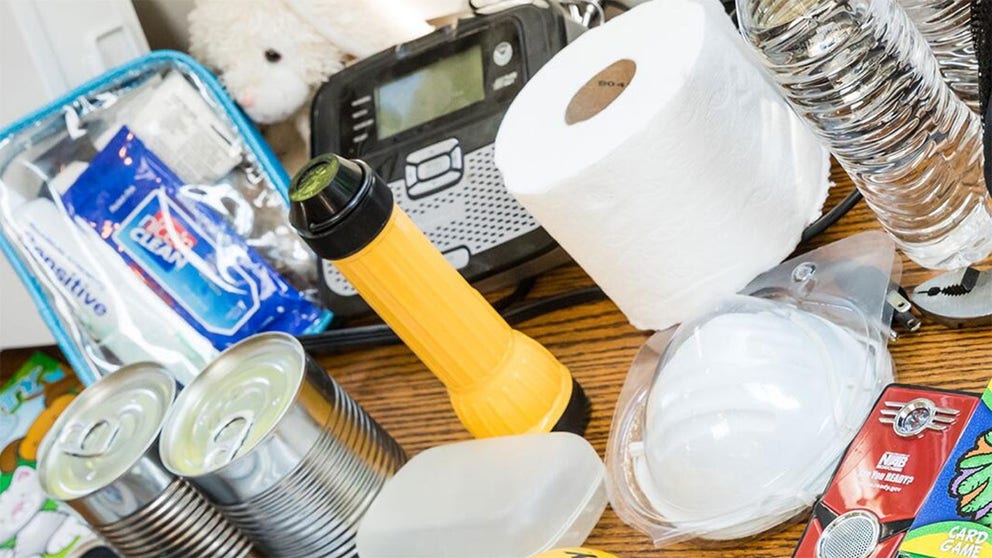Where tropical storms and hurricanes typically occur during each month of Atlantic hurricane season
The areas most at risk for tropical storms and hurricanes change throughout the hurricane season
How to prepare for hurricane season
Preparing for a hurricane or tropical storm before one hits is critical to ensuring your safety and protecting your property.
The Atlantic hurricane season officially runs from June 1 to Nov. 30, but tropical storms and hurricanes tend to occur in different parts of the ocean basin during each of those six months.
Here's a breakdown of where you can expect to find tropical storms and hurricanes in each month of the season.
HOW TO WATCH FOX WEATHER ON TV
June
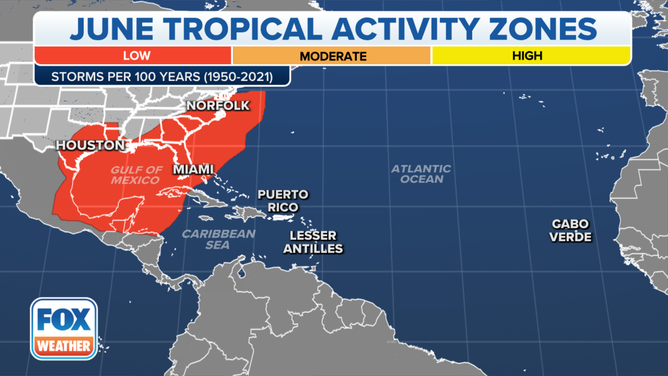
This map shows where tropical cyclone activity tends to occur during June. The data are shown as the combined number of tropical depressions, tropical storms and hurricanes whose centers pass within 125 miles of a point on the map during a 100-year period. The analysis is based on data from the 72-year period from 1950 to 2021 but normalized to 100 years.
(FOX Weather)
The start of hurricane season is in June. While the month of June is usually not very active in the tropics, any named storms that do form tend to occur close to the United States, particularly in the Gulf of Mexico, the western Caribbean Sea and near the Southeast and mid-Atlantic coasts.
These storms typically track toward the north or northeast, which means the Gulf and Southeast coasts of the U.S. could potentially be in their path.
HERE'S WHY THE ATLANTIC HURRICANE SEASON RUNS FROM JUNE TO NOVEMBER
July
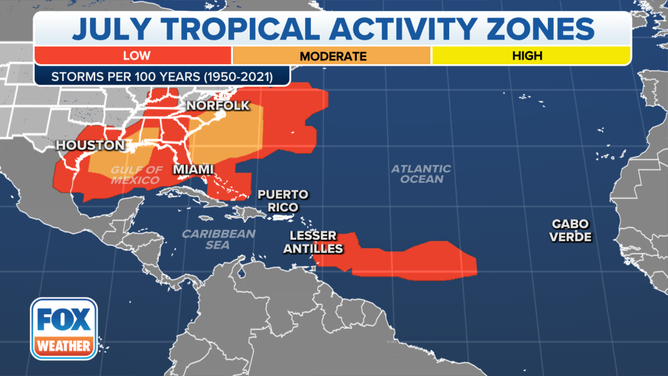
This map shows where tropical cyclone activity tends to occur during July. The data are shown as the combined number of tropical depressions, tropical storms and hurricanes whose centers pass within 125 miles of a point on the map during a 100-year period. The analysis is based on data from the 72-year period from 1950 to 2021 but normalized to 100 years.
(FOX Weather)
July is generally another slow month in the tropics before the Atlantic hurricane season ramps up in August and September, but there is a slight increase in activity as additional real estate for tropical development opens up.
Tropical storms and hurricanes most frequently occur off the Southeast and mid-Atlantic coasts, but they can also roam the Atlantic Basin anywhere between the northern Bahamas and Atlantic Canada, in the Gulf of Mexico, the eastern Caribbean Sea and the western tropical Atlantic (to the east of the Lesser Antilles).
However, the western Caribbean Sea turns less active in July because cold fronts become much less frequent in that region.
HERE'S HOW TO PREPARE FOR HURRICANE SEASON NOW
August
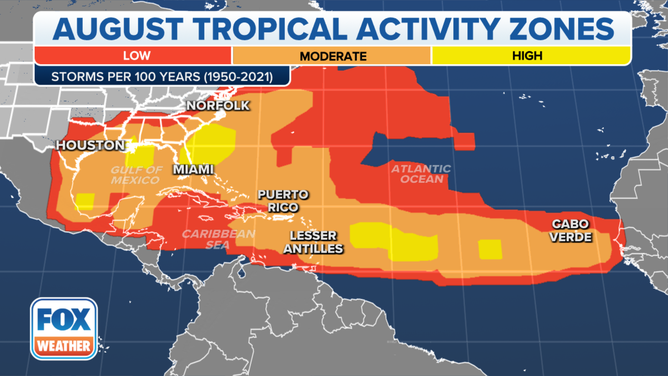
This map shows where tropical cyclone activity tends to occur during August. The data are shown as the combined number of tropical depressions, tropical storms and hurricanes whose centers pass within 125 miles of a point on the map during a 100-year period. The analysis is based on data from the 72-year period from 1950 to 2021 but normalized to 100 years.
(FOX Weather)
The tropics turn far more active in August when nearly the entire Atlantic Basin becomes available for tropical development, including the so-called Main Development Region between Africa and the Lesser Antilles.
Frequent tropical waves in warm ocean waters emerging off western Africa are seeds for tropical development in the Main Development Region. If a tropical wave spawns a tropical storm, it often moves westward across the tropical Atlantic Ocean in the direction of the Lesser Antilles. From there, it can either continue westward into the Caribbean or curve northwestward toward the Bahamas, eastern U.S., Bermuda or the open ocean.
Hurricanes that develop to the west of Africa are called Cabo Verde hurricanes, named after the island country a few hundred miles west of continental Africa.
The Gulf of Mexico continues to be a breeding ground for tropical storms and hurricanes in August as well.
WHAT TO DO WHEN HURRICANE OR TROPICAL STORM WATCHES AND WARNINGS ARE ISSUED FOR YOUR TOWN
September
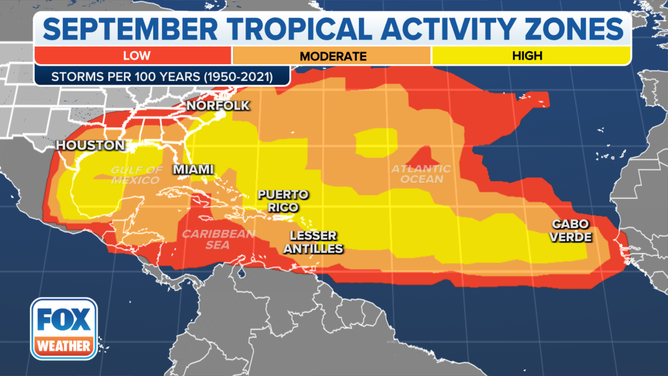
This map shows where tropical cyclone activity tends to occur during September. The data are shown as the combined number of tropical depressions, tropical storms and hurricanes whose centers pass within 125 miles of a point on the map during a 100-year period. The analysis is based on data from the 72-year period from 1950 to 2021 but normalized to 100 years.
(FOX Weather)
September is the most active month of the Atlantic hurricane season and when most hurricanes occur. More real estate is available for tropical development in September than any other month, so it's no surprise that hurricane season peaks on Sept. 10.
Cabo Verde hurricanes are common in September, and some of them make the 3,500-mile-long journey from the eastern tropical Atlantic Ocean toward the islands of the Caribbean or the United States coastline, while others curve northwestward toward Bermuda or the open ocean.
Another hot spot for tropical storms and hurricanes to form is the Gulf of Mexico, particularly the northern Gulf of Mexico to the south of Louisiana and Mississippi, as water temperatures in the Gulf reach the highest levels of the year.
WATER FROM HURRICANES, TROPICAL STORMS KILLS MORE IN U.S. THAN WIND
October
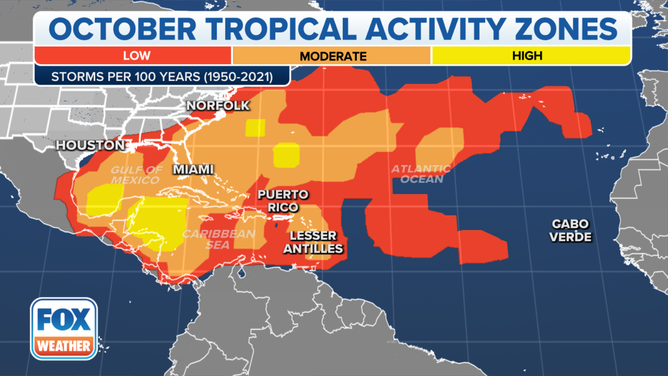
This map shows where tropical cyclone activity tends to occur during October. The data are shown as the combined number of tropical depressions, tropical storms and hurricanes whose centers pass within 125 miles of a point on the map during a 100-year period. The analysis is based on data from the 72-year period from 1950 to 2021 but normalized to 100 years.
(FOX Weather)
Tropical activity gradually starts to wane in October, but it can still be an active month for tropical storms and hurricanes to form, especially the beginning of the month.
Most areas of the Atlantic Basin remain open for tropical development, but the Cabo Verde season fades away, so a lot of the activity tends to shift westward.
The western Caribbean Sea, the eastern Gulf of Mexico and the western and central Atlantic Ocean are the areas most likely to have a tropical storm or hurricane in October. This still places parts of the Gulf and East coasts at risk for a landfalling storm to occur.
South Florida has been impacted by more hurricanes in October than any other month. Through 2021, 26 October hurricanes had passed within 100 nautical miles of Miami since recordkeeping began in 1851, according to NOAA's Historical Hurricane Tracks.
HOW TO STAY SAFE AFTER A HURRICANE
November
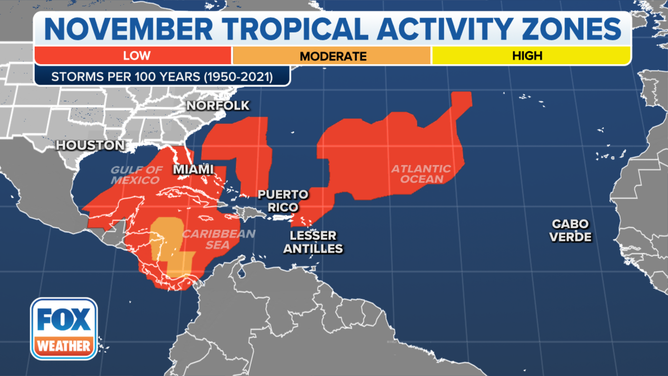
This map shows where tropical cyclone activity tends to occur during November. The data are shown as the combined number of tropical depressions, tropical storms and hurricanes whose centers pass within 125 miles of a point on the map during a 100-year period. The analysis is based on data from the 72-year period from 1950 to 2021 but normalized to 100 years.
(FOX Weather)
The Atlantic quiets down during the final month and end of hurricane season in November.
7 FACTS TO KNOW ABOUT HURRICANES
However, tropical storms and hurricanes can still form, and those that do tend to occur in the western Caribbean Sea, the southwestern Atlantic Ocean or the open waters of the central Atlantic.
In 2020, Eta made two landfalls in Florida during November, both as a tropical storm. This was after it produced catastrophic flooding in parts of Central America as a Category 4 hurricane.
CLICK HERE TO GET THE FOX WEATHER UPDATE PODCAST
Be sure to download the FOX Weather app to track any storms in your area and receive potentially life-saving weather alerts issued by the National Weather Service. The free FOX Weather livestream is also available 24/7 on the website and app and on your favorite streaming platform. The FOX Weather Update podcast also provides weather information for the entire country.
